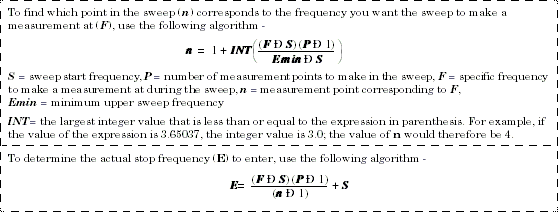Swept Audio Measurement Description
Last updated: January 16, 2009
Description
How are swept audio measurements made?
Swept audio measurements synchronize the frequencies of the test set's audio generator and audio analyzer instruments to automatically make measurements at up to 60 frequency points. Audio level, SINAD, and distortion measurements can be performed at each measurement point in the sweep.
This measurement only generates and analyzes audio signals; no modulation of the RF generator, or demodulation by the receiver, is performed. A representation of this operation is shown below.
To perform the swept audio measurements, you must route audio generator signal to the AUDIO OUT port (not the FM Demod signal). See Interactions with the Audio Analyzer and Audio Generator Instruments . The audio signal from the device under test is sent to the audio analyzer through the AUDIO IN ports.
The start and stop frequencies for the sweep define the frequency range. The user specifies the number of measurement points, which are evenly spaced through the specified frequency range.
Measurement settling time can be set to specify how long the audio signal is generated at each frequency before a measurement is made by the audio analyzer. This is used to account for settling time in the device being tested and any signal delay through the device. Increasing the settling time increases the sweep time.
If the 100 Hz BW bandpass filter is selected, the center frequency of the filter is synchronized to the audio generator and audio analyzer frequencies.
Typical applications include measuring the audio distortion of a mobile station across several frequencies and measuring the frequency response of an audio filter or amplifier.
This is not a measurement procedure specified in the EIA/TIA standards.
Operating Considerations
Front Panel Access
Swept Audio measurements are accessed manually by pressing the front-panel Instrument selection key.
Multi-measurement Use
When multi-measurements are used with the swept audio measurement, the AF analyzer makes the number of measurements specified at each point in the sweep. For example, if five measurement points are specified, and the multi-measurement count is set to 20, a total of 100 measurements are performed during the sweep.
Interactions with the Audio Analyzer and Audio Generator Instruments
To route Audio Generator signal to the front panel AUDIO OUT port, use the "SYSTem:AUDio:OUTPut:SOURce" command or press the
System Config
hardkey, then select
Audio Out Port
(
F1
) on the System Config Screen (2 of 2).
The Swept Audio measurement and the Audio Analyzer instrument cannot be used at the same time to make audio measurements. If you enable either function while the other function is already enabled, the first function is turned off and a message is displayed that informs you of this situation.
Selecting the Swept Audio measurement will automatically adjust Audio Generator instrument settings. These settings will not be restored to their original values when the Swept Audio measurement is closed.
The amplitude of the Audio Generator instrument can be changed while the Swept Audio measurement is enabled. However, trying to change the Audio Generator instrument's frequency while using swept audio measurements is not allowed, and causes an error message to be displayed.
Specifying a Specific Measurement Frequency Point Within a Sweep
If you need to make sure that a measurement is performed at a specific frequency within the sweep, you can use the following algorithms to calculate the values to enter:

For example if you wanted to make a measurement at 1004 Hz (F) during a sweep of 15 points (P) that begins at 300 Hz (S) and ends after 3 kHz (Emin), the first algorithm tells you that 1004 Hz occurs at the fourth point in the sweep (n). Use the second algorithm to calculate the actual stop frequency (E) you would enter for that sweep (3585.333 Hz).
Related Topics
Programming a Swept Audio Measurement
Swept Audio Measurement Troubleshooting
Audio Analyzer Measurement Description
Audio Level Measurement Description
